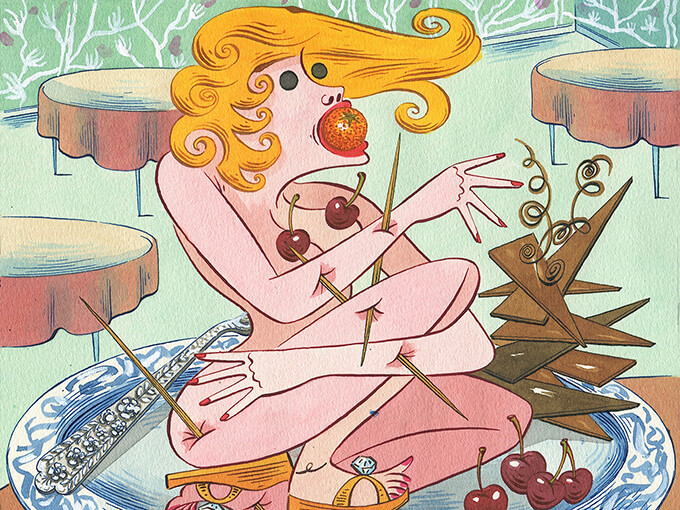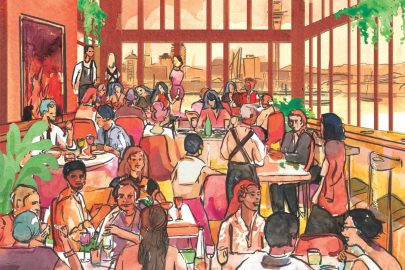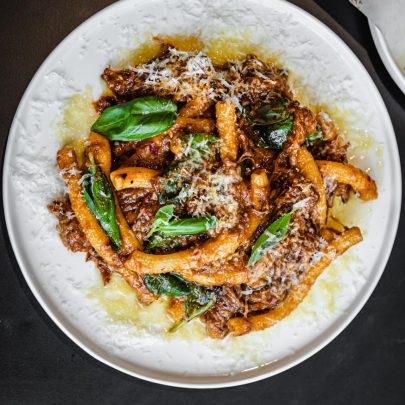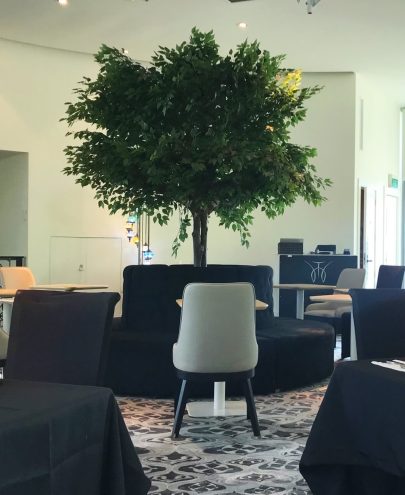Jan 9, 2020 Restaurants
A decade is a really long time in hospitality: cities change, their people change and the food scene changes. Back in 2010, Karangahape Rd had Coco’s Cantina — then a year old — and Satya, and not a lot else. Ponsonby Rd was the place to be, and there was almost nowhere to eat in the CBD. Ten years later, we consider the glorious failures, grand experiments and much-lamented closures that helped bring Auckland’s eating scene alive.
Mandarin
Mandarin was a very beautiful restaurant — designed by Cheshire Architects — in a basement on Fort Lane: you’ll know it now as Sid and Chand Sahrawat’s Cassia . Back then, it was darker, moodier, with incredibly low lighting and a menu of dumplings and Yunnan, Hunan, Sichuan and Xinjiang food — a self-described “exploration of China’s culinary heartland” — and a very good wine list. It was meant to take Chinese food from cheap eats to high end, and it succeeded, briefly. I remember going to a lunch at which we drank a $1000 bottle of something French, paid for by the owner, and I wondered where his money came from; maybe it was predictable that it folded a few months later, owing $320,000 to its landlord, architects, breweries, vineyards and a magazine publisher. The owner vanished soon after.
Libertine/Matterhorn
Remember Pack & Company? The hospitality group burst into Auckland in a big way in the early 2010s, opening a bunch of restaurants that were pitched at the city’s newly found need for casual dining. Some have lasted — Everybody’s is still there, and so is The Commons — though they all dropped off Metro’s Top 50 a few years ago. I always struggled with their restaurants: they seemed formulaic and undercooked, even more so once the new-opening crowd moved on and the buzz died down and the group moved its best staff to the new opening. In 2014, the group took over a space in Victoria Park that I remember as a 1980s McDonald’s and called it Libertine: it got a lot of PR, but I couldn’t now tell you what it did. A year or so later, it became Matterhorn, the Auckland version of the Wellington classic, and that wasn’t very good, either. I remember a cold, uninspiring evening eating large plates of meat. It now houses a souvenir shop.
Black Hoof
Oh, I loved Black Hoof, which was a Spanish-ish tapas-y bar in the space that is now Culprit, started by a fellow named Will who used to work at Casita Miro . It was great — a lovely spot for a beer. It lasted about two years; for some reason, Auckland wasn’t ready for a casual little bar at the top of the stairs, and its closure was one of those things that makes no sense.
Clooney
Clooney, which could be described as Auckland’s most ambitious restaurant, opened in 2006 in a beautiful space designed by Fearon Hay. Through successive chefs, the desire of owner Tony Stewart to raise the bar — he once said he wanted the place to be New Zealand’s first on the World’s 50 Best Restaurants list — was palpable. Sometimes it delivered; sometimes it didn’t. It closed in 2019, after 13 years in the business, and the building is now for lease.
READ MORE: Goodbye to Clooney, 2006-2019
Ella
I’ve spent a lot of time in the space that is now Orphans Kitchen . Back in the 1990s, it was Stella, and around 2003, it was a Swedish-ish place called Koket (pronounced Sherkit, but everyone called it Cock-it — funnily enough, it didn’t last very long). And then it turned into a really good cafe, the name of which I can’t remember precisely — was it something like Season? — but which did really good baked Spanish eggs before that was a thing. Then it was Ella, which had red panelling (the same panelling that’s now pastel at Orphans) and a short but great bistro menu and a good wine list; I used to go for lunch and a glass of wine on Saturday afternoons.
Morita
Morita was mad, odd — and wonderful. It felt like a scene from Eyes Wide Shut, a basement just off Albert St with faux columns and black tablecloths and a French-Japanese menu featuring burgundy and American lobster. The cooking was fantastic but the place was murderously expensive and it lasted maybe two years. I think there’s a mini-mart there now.
Bi-won Korean BBQ
RIP Bi-won. The last word in Korean barbecue used to operate out of a bland space down an awkward side road in Wairau Park. It was terrific. The owner had previously been a butcher, and he imported charcoal and condiments from Korea; you’d order, and he’d bring you a bucket of glowing charcoal, pouring it with a flourish into the barbecue in front of you. I still miss it.
Delicious/Siostra & The Refreshment Room
Oh, Delicious, how we loved you — at least in the early days, when there was brilliant hand-made pasta and a queue out the door. These days, it’s Lilian , after a few years as Siostra, which I never forgave for serving me an awful dish of overcooked T-bone steak on too much mash. Delicious was really at its best when Hayden Phiskie and John Pountney were running it; it lost something when they sold up, but there was the consolation that you could go to Titirangi and eat at The Refreshment Room, until they sold that, too. Now, they’re running Cotto, and you should go there before they get bored and do something else.
Sakanaya
Sakanaya was a brilliant, underrated Japanese surf shack in one of those odd little spaces below the leaky building on Symonds St that just got rebuilt. It had a woodsy interior dressed with surfboards, and killer food, including cha wan mushi (savoury egg custard) and grilled sardines. Auckland is the lesser without it.
Sunday Painters
Now this is a sad story. Isobel Thom, James Kirkwood and Esther Lamb opened Sunday Painters in Ponsonby in 2010; they had previously been in a painting group. It felt like a granny-ish sort of sitting room, with green walls, old chairs and tablecloths, granny plates and mismatched cutlery. The cooking was wonderful, classic — slow-cooked lentils with duck-neck sausage, say, or a slow-cooked duck confit; there were lamb shanks and a most excellent cassoulet. How we loved it! Then it got too successful and the partners were working too hard, so they sold it to someone who had clearly never run a restaurant before and it died shortly after (illustrated at left, from Metro November 2013). It’s now Po’ Brothers.
Merediths
I’m looking forward to eating at Michael Meredith’s new restaurant when it opens this year in Britomart. Merediths was his fine-dining restau-rant on Dominion Rd, and it opened in 2007 just before I went overseas. By the time I got back, it was the go-to fine-diner in Auckland; I once ate a venison tartare there that has continued to define the dish for me. Meredith sold it a couple of years ago, a sign many took to mean the beginning of the end of fine-dining in Auckland; more likely, it was the beginning of the end of classic fine-dining, all starchy tablecloths and hush.
Rocco/MooChowChow
Back before Mark Wallbank specialised in rowdy Asian-influenced restaurants, he had a rowdy Spanish-ish restaurant called Rocco on the corner of Hepburn St and Ponsonby Rd, in a big old house that was basically rebuilt for the restaurant and that opened in the early 2000s, providing a launching pad for many Auckland hospo stalwarts. Rocco was a partnership between Wallbank and Blair Russell; they also owned Magnum. When they split, Rocco became MooChowChow and Magnum became the Ponsonby Road Bistro . MooChowChow was the first place in Auckland to come very close to what Thai food should taste like, and it was a hell of a lot of fun — I loved the massaman curry, a fiery version of something that is often so bland, and the betel leaf entrées were magnificent.
District Dining
You’ll know Mimi Gilmour as the powerhouse behind Burger Burger; before that, she was part of Mexico, but her first foray in Auckland was opening District Dining, a beautiful space behind white shutters on Customs St, an Auckland branch of her and ex-partner Warren Turnbull’s District Dining in Sydney. It was part of the Britomart renaissance and one of the first places with a really, really good fitout. It closed inside a year, to be replaced by the awful Orleans.
Beirut
Mouthful Group was lucky to have Javier Carmona, the Spanish-Australian chef who seems to be able to turn his hand successfully to any cuisine. He started at Mexico and headed up most of their restaurants, including Beirut — a directional Middle Eastern eatery with a darkly industrial fitout. Everyone loved it except me: the flavours were good and the space was spectacular, but it felt art-directed, too knowing, a generous, big-hearted cuisine reduced to being clever. It wasn’t Carmona’s fault, and nor was his next go: the South American Inti, in a space on O’Connell St, which served clever versions of South American classics but still felt gutsy and real. Lamentably, it lasted only a few months — another lost restaurant, another visionary place Auckland should have held onto.
This piece originally appeared in the January-February 2020 issue of Metro magazine, with the headline ‘Dead restaurants’.






